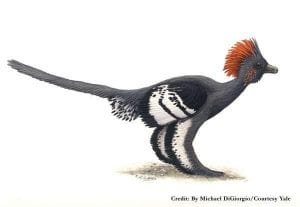It might seem unbelievable, but dinosaur researchers can now tell the colour of dinosaur feathers. The story began in 2010, when two papers were published by two independent groups of researchers, one for Sinosauropteryx and the other for Anchiornis. Theropod dinosaurs close to the origin of birds had a diversity of feathers and these feathers were richly coloured and patterned.
 Two reconstructions were published, showing Sinosauropteryx with ginger feathers all over, and a ginger-and-white striped tail, and other showing Anchiornis, embellished with black and white stripes on its wings, a red crest and red speckles on its cheeks. Do we believe these reconstructions? How are they any better than guesswork?
Two reconstructions were published, showing Sinosauropteryx with ginger feathers all over, and a ginger-and-white striped tail, and other showing Anchiornis, embellished with black and white stripes on its wings, a red crest and red speckles on its cheeks. Do we believe these reconstructions? How are they any better than guesswork?
 In fact, there is solid, testable evidence for these reconstructions, and they are testable. This is science. Read the book to find out the whole story.
In fact, there is solid, testable evidence for these reconstructions, and they are testable. This is science. Read the book to find out the whole story.
Further work concentrates on feather preservation, feather function, and feather evolution.
There has been debate about how well ancient feathers can be preserved, and whether the organic chemicals are original. First, it has been shown that the pigment melanin survives for millions of years and the ancient form matches experimental degradation experiments. Whether the feather keratin survives is debated. Skin can survive as flakes – dinosaur dandruff. A tiny dinosaur tail, with feathers, was even found in amber in 2016.
What did dinosaurs use their feathers for? It was long assumed that insulation came first, then flight. New discoveries confirm that. But it was surprising to find that the theropod dinosaurs Anchiornis and Sinosauroptyeryx showed sharp stripes and patches of colour – they were already using their feathers for display. New in 2016 was the discovery that several dinosaurs at least also showed countershading – part of a camouflage system.
When did feathers evolve? At first, it was thought only certain derived theropods, close to birds, had feathers. Then, ornithischians such as Tianyulong and Psittacosaurus were found to show feather-like structures, and in 2014, an ornithischian dinosaur with diverse feathers, Kulindadromeus, was reported. Perhaps, we suggested, all dinosaurs had feathers? Then, in 2019, pterosaurs with four kinds of dermal structures, some showing branching, were reported. Were these feathers, and if so, did feathers then originate 80 Myr earlier than thought, at the root of the common ancestor of dinosaurs and pterosaurs, some 250 Myr ago, in the Early Triassic?
The story of the astonishing new dinosaurs and early birds from China, adorned with feathers which are so well preserved that colours and functions can be determined, and which show feathers originated long before birds, have changed the subject area out of all proportion. Read first-hand what happened, and how the science works, in Dinosaurs Rediscovered.

